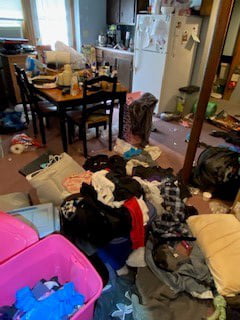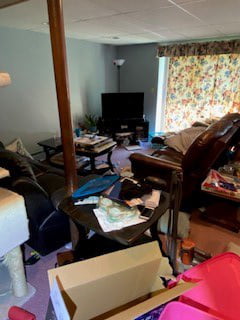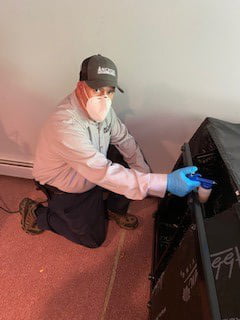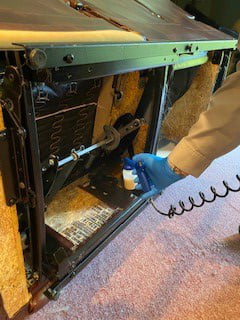In collaboration with Keith Harrington, A.C.E., Anchor Pest Services, www.anchorpestservices.com

Background
Keith Harrington has been in the pest control business for 14 years. Bed bug work makes up a very small portion of Anchor Pest Services’ work, but there was a need to do their best for an elderly client with a very-high-level infestation situation. In their own words, “You’ll never hear us say we went ‘above and beyond’ for a customer. To us, there is no such thing. Nor is there an extra mile, or one step further. It’s all a part of what we do.”
The client was a 95-year-old, house-bound person, who received regular nursing visits. The client reported first seeing activity 3 weeks prior to inspection and had attempted to self treat with over-the-counter products. The property was a single-family home with a basement studio apartment housing an adult relative. There was a high level of clutter, which made proper inspection difficult (Figure 1). However, the level of infestation, indicated that issue had been going on for much longer than reported by the client (Figure 2).


Figure 1 The basement studio was filled with a large amount of clutter.


Figure 2 The mattresses exhibited signs of long-term infestation including live bed bug activity.
Keith first read about Aprehend in PCT magazine and had been enjoying success with Aprehend for a year. Keith knew Aprehend was a perfect fit for this client’s situation, given its Direct Transfer Action where bed bugs take Aprehend back to the harborage and share it with all of their friends. In high infestation levels, combined with multiple and often difficult-to-reach harborages, Aprehend really has the edge over other products.
Treatment
This was an Aprehend-only treatment. Prep work by client was better than anticipated—they cleaned clutter to allow access to all furniture and baseboards. They vacuumed and laundered/bagged all linen. All items were removed from under the beds. Anchor’s prep consisted of light additional vacuuming of live bugs pre-treatment and moving minimal client items and furniture to access the box springs and bed frames.
There were 3 bedrooms with a mattress and box spring in each bedroom. Anchor vacuumed live bed bugs and debris from the mattresses but did not encase them. All three box springs and bed frames were treated with Aprehend, as well as the living room sofa and recliner (Figure 3). The backside of dressers and cabinets in the bedrooms were treated. All baseboards were treated, as well as around light switch plates and electrical outlets.


Figure 3 The underside and non-seating areas of sofas and chairs were treated.
The entire basement studio apartment was treated, with the exception of the bathroom. Anchor used ~10oz. of Aprehend for the initial treatment due to the number of furniture items and areas that required treatment.
Results & Post-Treatment
Given the level of infestation, Anchor had anticipated a need to retreat on their 30-day follow up service. The technician confirmed that there were still some live bugs, so Anchor applied ~3oz of Aprehend to the bed frame and around the outlets behind the bed and the backside of the furniture next to the bed. They also reapplied to the underside of one chair in the living room.
A follow-up visit 44 days after the initial application matched the client’s findings: no bed bug activity.
Moving Forward
Anchor Pest Services uses Aprehend-only whenever possible. Keith says, “The minimal prep required by the customer, the time spent on site by technicians, and the great results make it our clear choice.”
Suggestions for PMPs Using Aprehend
Anchor finds it critical to clearly communicate the proper expectations to the customer: activity can be seen for up to 3 weeks based on the life cycle of the bed bugs, they need to continue to sleep in beds, leave barriers intact, etc. This helps set the client up for success.
Read other case studies here, then put Aprehend to work for you. Give us a call at 800-891-8610.
